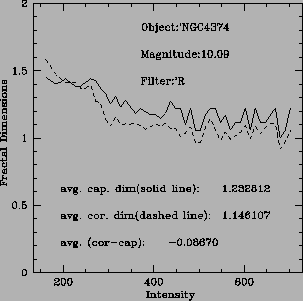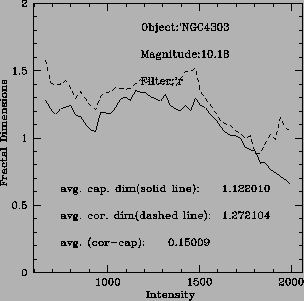



Next: Results
Up: FRACTAL DIMENSIONS OF GALAXIES
Previous: Contour Generation
Running the program Fd3 (described in chapter 3) on the contour data
files calculated capacity dimensions and correlation dimensions of the
contours. 50 contours were created for a range of intensities for each
galaxy. The range was determined by the sky value and the number of
points required by the fractal dimension program. As the background
of a galaxy image is the sky, at the intensity value of the sky most
of the image would be filled with the contours around this value.
This would make the fractal dimensions very high (close to 2) for all
the images and would be useless for classification being common in
both elliptical and spiral galaxies. The intensity values around the
mean sky value, therefore, could be considered noise. As one moves
to higher intensity values from the mean sky value, this noise starts
dropping and one begins to get contours from the galaxy. Therefore,
the lower side of the range for contour generation was set to the mean
intensity level of the sky plus four times the standard deviation
around the mean sky value. The minimum number of data points required to
obtain reliable fractal dimensions is 10d, where d is the true
fractal dimensions of the object (Liebovitch and Toth 1989).
Since we are dealing with the geometrical objects with
unknown fractal dimensions, deciding the minimum number of data points
is difficult. Therefore, knowing that the fractal dimension of a two
dimensional object cannot be greater than 2, a minimum of 200(significantly greater than
102 = 100) points were initially used.
Running the program on several galaxies led to the conclusion that
their fractal dimension, on average, is significantly less than
1.7. This gives us the minimum of
 .
To be on the
conservative side, a minimum of 80 was chosen. At high intensity
levels, closer to the center of a galaxy, the contours start to become
smaller, containing fewer data points. At one point, the contours run
out of the minimum required data points (80) setting the higher side of the
intensity range for generating contours. This range was divided into
50 intensity levels and fractal dimensions were computed for contours
around each level.
.
To be on the
conservative side, a minimum of 80 was chosen. At high intensity
levels, closer to the center of a galaxy, the contours start to become
smaller, containing fewer data points. At one point, the contours run
out of the minimum required data points (80) setting the higher side of the
intensity range for generating contours. This range was divided into
50 intensity levels and fractal dimensions were computed for contours
around each level.
Figure 8 shows example of fractal dimensions for two of the galaxies
computed using the Fd3 program. The examples show fractal dimensions of 50
contours generated for different intensity values for an elliptical
galaxy (NGC 4374) and a spiral galaxy (NGC4303). The average correlation
dimension is significantly lower for the elliptical galaxy than
the spiral relating to its less complex structure. The average
capacity dimension on the other hand is higher for the elliptical
than the spiral galaxy, which contradicts our expectation.
Figure 8:
Fractal Dimensions of NGC 4374 (Elliptical) and NGC 4303 (Spiral)

 |




Next: Results
Up: FRACTAL DIMENSIONS OF GALAXIES
Previous: Contour Generation
Sandip Thanki
1999-07-29

